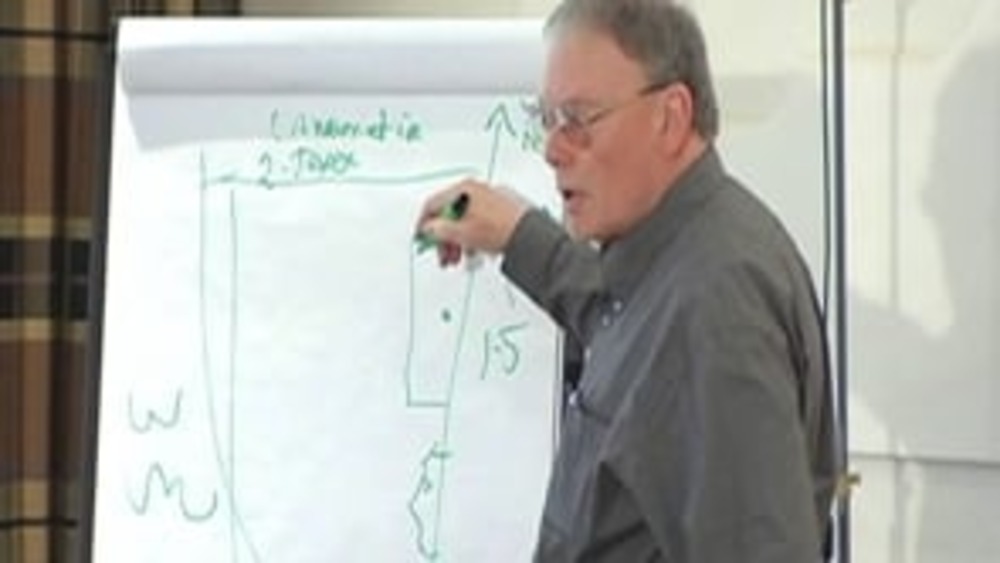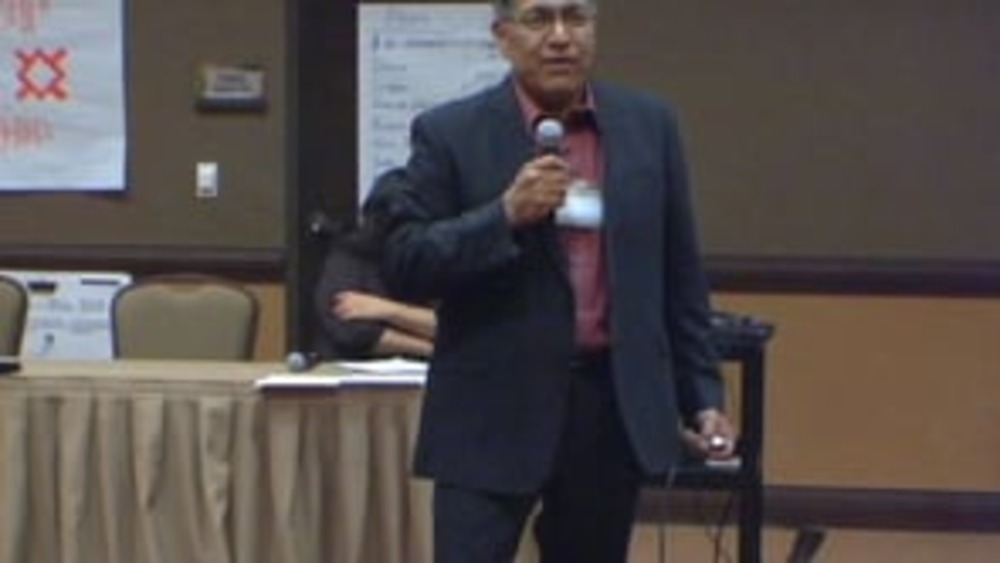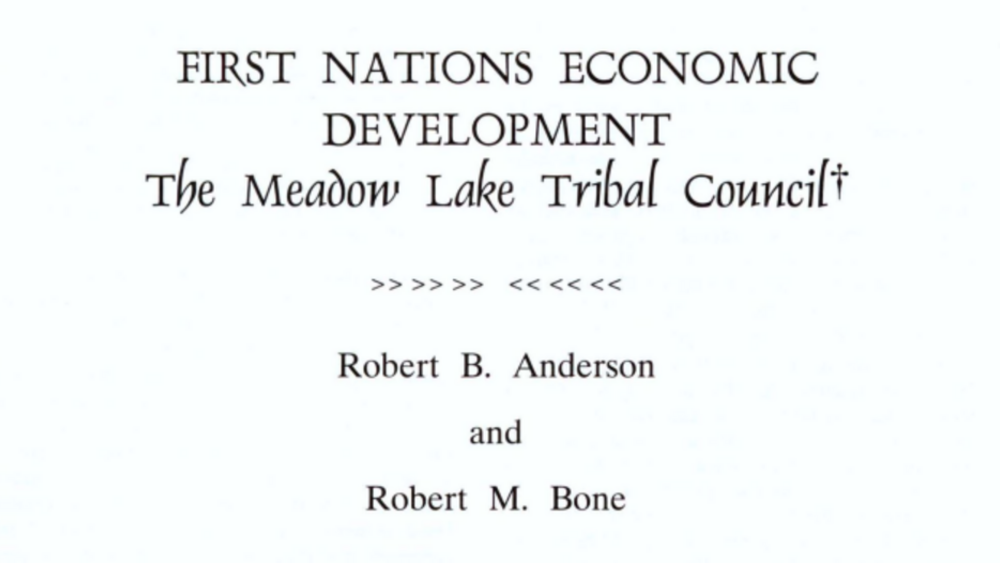Former Meadow Lake Tribal Council (MLTC) Chief Helen Ben provides an overview of the various enterprises owned by MLTC, an intertribal organization formed for economic development purposes.
Additional Information
Ben, Helen. "Nation-Owned Businesses: The Meadow Lake Tribal Council." Building and Sustaining Tribal Enterprises seminar. Native Nations Institute for Leadership, Management, and Policy, Udall Center for Studies in Public Policy, University of Arizona. Tucson, Arizona. March 29, 2007. Presentation.
Transcript
"I'd like to thank you for inviting us I guess -- Vern [Bachiu] and I -- to your seminar here. It's nice to be here in this country like Vern indicated. Back home the snow is up to this high, so it's really a lot different for me to be able to wear a short sleeve shirt during this time. One of the things that I think that the bio here indicated is I've been involved in the education field for quite some time and that's the background that I come from. I'm Cree from Makwa [Cree language]. You didn't slaughter the name; it was actually very well done. The spelling is quite hard and it actually indicates, it says Makwa Lake and if you change the pronunciation just a slight little variance on pronunciation from Makwa [Cree language] to Makwa [Cree language] you're saying 'Makwa Lake' or 'Makwa nail.' So just a slight little change there and that's what it indicates -- the language that I come from. But anyway, I'm glad to be here and I'd like to thank the elder for doing a prayer for us. It's nice to have that. Back home we also do that, we always ensure that we always start off with a prayer because that's something that's important to us.
I'll just go into my presentation here right away here and hopefully I can see the screen quite well here. So we have been invited here to come and talk about our tribal council a little bit so we'll give you some background on that. Our vision is to create some health through our programs, create wealth through our business and create good governance through our political arm. We're involved with some forestry interests. We'll give you a little bit of run down on that, a little bit of history on that. We own a sawmill, which is named Norsask, and we're also in partnership in terms of Mistik, a forest management license that we are part of. We have some challenges in terms of ownership and we've been asked to lift our corporate veil and to speak honestly about some of our businesses and some of the challenges that we're experiencing with our tribal council.
A general description of MLTC (Meadow Lake Tribal Council): MLTC is the political program and service and corporate organization of nine First Nations in northwest Saskatchewan. And there you have a map that sort of indicates Saskatchewan as a whole there and the shaded area, the light shaded area, is where our tribal council lands exist. MLTC's goal is to achieve economic and social parity with the overall provincial population. We're composed of nine Meadow Lake First Nations, which we'll refer to as MLFNs, and MLFNs are signatories to either Treaty Six, Eight or Ten. We're composed of four Dene and five Cree [nations] and our population is approximately 11,000. We experience many of the developmental challenges common to most Canadian First Nations and our population is quite young. We were just talking about that yesterday, Vern and I, as we were flying in. We talked about our numbers and between the ages of 15 to 25 our population is 40 percent. So that's actually quite a huge number.
Good governance in creating health in political governance. Our first purpose is to protect and enhance the treaty rights of our membership. When they came together to form the tribal council, that was the first mandate, and we set up a government-type structure to govern our tribal council. And we also provide a lot of programs. We offer a full range of services such as things in health, education, etc., to our communities. Creating wealth through our corporate development -- resource development -- we have concentrated on participating in the resource development opportunities in our traditional territories. Some of our area of course is comprised of quite a bit of forestry area so we've been able to do that. We own a number of businesses. We own or have investments in ten businesses altogether and we own and operate our own investments. The following chart shows these businesses and will indicate some of the solid lines where we have some 100 percent ownership and some broken lines indicating investments and that will be on a short slide after this. Our gross sales: combined, our businesses have total sales of between $50-60 million. And we have a strong reliance on forestry, which is our main business interest and has been for quite some time. So 75 percent of what we do is in forestry.
This is our business investment structure that we have. These are some of the businesses that we're involved with. In forestry, we own 100 percent of a stud mill, which is Norsask Forest Products, and along with this we also have a forest management license and we own 50 percent of that. Meadow Lake OSB, which is located in Meadow Lake, which is where we're located, we have an option to buy 10 percent. Right now we have a one percent share on that. In energy, we have Polar Oil and what it is is a diesel and home, heating fuels, fuel cells that we provide to some of our northern communities and Resource Development, Inc., which are natural gas storage facility in the south area. Transportation, Northern Trucking 100 percent, we own 100 percent of that and what it is is a wood shipping trucking business that is an offshoot of our major business, our Norsask Forest Products. West Wind Aviation, 25.5 percent of that, and it's an air charter service that's located in Saskatoon and what they do is they provide air charter to the northern mines and so forth. Value-added agriculture, Ceres MLTC Fertilizer, 50 percent ownership in that one, which processes and markets ammonium. La Ronge Wild Rice Corp., which is -- one of our northern communities is La Ronge -- and we own, we have a little partnership with them, 21 percent. We process and market wild rice. Real estate, we own a warehouse within our lands in Meadow Lake. Hospitality, we have some shares within that also, Western First Nations Hospitality, 10 percent, and that's some Super 8s [motels] within Saskatoon, PA [Prince Albert], surrounding towns.
So our main focus is our forestry, the Meadow Lake Sawmill, and we'll give you sort of a brief history of this. Meadow Lake Sawmill owned and operated as a government-owned company. When it first started, it was an inefficient mill and it was losing approximately $2 million annually. In 1988, the government changed and the new government wanted to privatize the mill. So they approached the employees who then formed the company to buy 50 percent of the mill. They approached MLTC and they offered to sell us the remaining 50 percent. It was a new company [that] was formed, Norsask Forest Products, and a $3.2 million forestry license came with the sawmill. It produces 110 million board feet annually with an annual allowable cut of 400,000 of soft wood.
Some earlier challenges: there's always some challenges that come with a business sometimes. So some business challenges that we had to overcome, buying a mill. One of the challenges that we had was bringing together the unionized employees and nine First Nations to buy the mill. Of course this is not a recipe for business turnaround that you could learn from the Harvard Business School. So there was quite a few challenges that we had to go through with that. Turning around a money-losing sawmill was also another thing. This sawmill was losing quite a bit of money annually. So we invested heavily in the modernization of the mill and we hit a decade of high lumber prices and we had unrestricted access to U.S. markets. So we produced lumber in Canadian dollars and sold in American [dollars].
Some business successes, and this was probably the first thing that was really looked upon as the leadership at the First Nation level. The first dividend payment -- first time in history our communities have received a payment from somewhere other than the government from the tribal council investment. So it was really a turning point for us and it created a prosperity cycle. It created a cycle of prosperity as illustrated in the following chart. This chart here indicates our prosperity cycle. We started off with our forests, our lands and our traditional territories. There was some offshoots, some contracting out to First Nations. We had people out there at land base who were actually getting million dollars worth of equipment to do some of the work that we were doing with our forestry. There were some milling of course that happened with our mill there. And then some spinoffs, our Northern Trucking spinoff, who would haul some of the residual, the wood chips and so forth to other places. And then in the end, what it provided for our community was some community benefits. Those profits -- when accrued back to the communities -- they were reinvested in things like housing, some youth programs, some recreational programs and so forth.
Corporate success enhances political goals. Our forestry license falls within our traditional territories and that area here, the one in the red, is part of our traditional territories. We have been able to gain significant control over our traditional lands and forestry, which is a political objective through corporate means. So Mistik utilizes a system of co-management boards, which enables local people to have a say. They have a say in things like annual cutting plans, exclusions and contracting benefits. Legal structure challenge: in 1988 we held our interest to a limited corporation. We struggled to find a way to hold our interest free of income tax and we saw a limited partnership as the means to provide the liability protections and exemptions from income tax that we were looking for. We wanted to insure that there would be no liability back to the tribal council or any programs and services. So there was that link, we needed to make sure that that link wasn't there. After a decade of ownership, the employees were looking to sell out their interest. And then in 1998, we became 100-percent owners of the sawmill and we reorganized into a limited partnership to be more tax efficient.
There has been of course some governance challenges, as there always is sometimes. Board of directors, we have strict banking comments given that our leverage buyout in 1998. One such comment was it required our board to be comprised of independent directors. So it was a discipline that has proven very important and valuable to us and it has worked really well. We still maintain a board of independent business people and the political leadership today. There is a tension between those chiefs who see their role on the board as putting the needs of their community before the needs of the business and it's an ongoing challenge. There is an ongoing tension in the ownership of the sawmill and one of the problems is the fact that if a chief is a director, if he, is he or she representing the needs of the business or the needs of his or her constituents? And you always have that problem. Do they put their business hat on or do they put their community leadership hat on? And that's always a challenge because sometimes, in some cases, those are conflicting roles.
Ownership challenges: managing expectations. MLTC sweared the initial investment in the mill on behalf of the nine MLFN owners. The mill appreciated rapidly and we were starting to see some dividends back to the communities. We undertook a leverage buyout secured only by the sawmill and the mill was able to earn substantial income, which was used as follows. Some of that was used to pay down the purchase debt, reinvest in capital expenditures, and make substantial distributions to the owners. The trouble was that in this scenario, the tribal council ended up doing the work and bearing the risk, and there's of course some political risk that we also bear along with that. The individual owners, the First Nations, came to expect that this was the normal way of doing business and we have missed out on opportunities to diversify by distributing too much income to the owners. So that's one of the problems that we always have is we need to retain some money so we can reinvest for new businesses and so forth. But the demand sometimes at the First Nation level is so great that we end up having to shell out some of that money in terms of dividends.
So going forward, some of the business challenges: We need to continue to manage our business through the worst forestry, markets and decades so we can survive until times get better. We're the only sawmill that has survived in Saskatchewan. It's very difficult times for sawmills across the nation right now. There's a downturn of course of demand and it's really affecting us. Ownership issues, there are seasons to politics. While we have faced difficult issues amongst the owners, it appears that the chiefs are prepared to find a solution. And basically they're prepared to come together and continue working together and we're looking at doing some political renewal along with some corporate renewal and we've been in that process for quite some time. Succession planning: We need to develop and execute succession plans for how we will replace key management. Over the past few years, we have proven that we can do that. And some of the leaders that have been there, some of the managers that have been there have been for quite some time. And when they've been there for quite some time, part of the process you need to insure is that there is some succession planning that happens through time. And in fact Vern is actually one of the individuals that will be leaving us as an organization after awhile and setting up his own business. And we're looking at doing some succession planning there to insure. And in some cases, it may be what we would of course like to prefer is that we trade some of our own First Nations, but in some cases you don't have those individuals. So you may need to look out and have a plan in place where you do some of that planning as you go along and training as you go along. So diversification, we need to capitalize on the opportunities around us and diversify our business interests into other resource sectors. And actually we're well positioned right now to overcome some of those challenges and to continue to grow and prosper.
We have a few challenges in place, but we also have some doors opening in our area right now. I don't know how familiar you may be with the oil and gas and what's developing in our area. In the Fort McMurray area in the northern Alberta area they have a lot of success in terms of oil and gas development. And in fact that door is opening for us in our area, in our traditional territories. Some of our northern communities, there's some drilling that's happening right now and those doors are going to be opening. In fact they are looking at hiring a lot of individuals. So the challenge for us now is looking at our population, our population base of 40 percent of our youth and looking at training them and making sure that we're making those connections with some of the job opportunities that will be there. So those are some of the challenges that we have and these are some of the logos of our First Nations. And its nine First Nations that we work with and I work with nine chiefs at the table. And I've got some very good experienced chiefs at the table and I've been in this for just slightly over a year, a year and a few months so it's actually very exciting for me, too."



